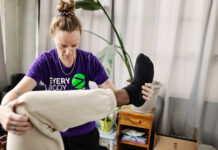When we hear of an “ACL injury” we might think of our favourite all-star athlete sidelined for several weeks or months due to some affliction to their knee. The ACL (Anterior Cruciate Ligament) plays an important role as a stabilizer of the knee connecting the lower (tibia) and upper (femur) leg bones. Think of it as a seatbelt that prevents the lower leg from sliding forward.
CAUSES OF INJURY
Many ACL injuries occur with non-contact movements in sports that involve rapid changes in speed and direction. These activities can increase the load on the ACL, and potentially lead to a sprain or rupture—the seatbelt can only take so much force! Because this injury is related to motions such as rapid deceleration, jumping/landing, and pivoting it is a common injury in sports like soccer, football, basketball, and skiing. ACL injuries can also occur in contact sports due to a direct blow to the lower portion of the knee from behind.
An injury to the ACL is often accompanied by an audible “pop” sound, as well as sudden pain and unsteadiness in the knee. The area can also experience enough swelling within the first few hours after injury that range of motion in the knee can become limited. Each year, nearly a quarter of a million North American athletes experience ACL injuries. Female athletes are three times more likely to be injured than male athletes due to differences in anatomy, hormones, neuromuscular control, and ligament laxity (similar to flexibility, but for ligaments).
The risk of an ACL injury is also influenced by factors such as a history of a previous ACL injury on the same or opposite leg, returning to sport too soon (less than nine months) following a first ACL injury, and higher levels of competition. In addition, sport surfaces, such as artificial turf, and cleated footwear contribute to higher forces being transferred to the knee during dynamic movements in sport, increasing risk of injury.
Thankfully however, our seatbelts are not the only restraints. Like modern cars have braking sensors and airbags that contribute to safety, our knees have mechanoreceptors that cue muscle control, and other ligament restraints (e.g. posterior cruciate ligament) that all work together to make the knee strong. This in part is why not all ACL injuries require surgery. So, whether preventing injury, recovering from an ACL injury, or recovering from an ACL surgery, an appropriate prevention/rehabilitation program can help reinforce the seatbelt and heighten the sensors to lower the risk of a knee injury.
EXERCISE AND PREVENTION
Research strongly supports preventative exercise programs that merge strength and balance throughout the lower extremity. It’s hard to drive a Ferrari on skinny bike tires! There are numerous tests that can be performed to look at this concept. These are dynamic tests that integrate hopping, jumping, leg drops or balance. One of our favourites, because of its practicality and validity, is the Star Excursion Balance Test. This test involves standing on one foot and reaching the other foot in different directions as far as you can without losing your balance. It is also a great way to find directional limitations and track your improvements with practice.
Specific exercises can help develop lower extremity strength. Combining this with muscle activation and coordination is like putting sticky racing tires on your Ferrari so you can get the power to the ground efficiently. Other effective exercises integrate exercise bands and unstable surfaces in sport specific patterns. We want to make your body resilient to any forces, including lateral, torsional and particularly shearing forces which can lead to ACL injury.
RESUMING EXERCISE
Even if a tear occurs, only about 35 per cent of people will need surgery. The evidence suggests that, as opposed to copers (people who get back to full function without surgery), non-copers have deficits in quadriceps strength, size, activation and coordination. In other words, they likewise need more strength and stability. There is compelling evidence that running long term is actually good for your knees, even if you have a preexisting injury. Even if surgery is required, running can be resumed at the right time after rebuilding functional attributes. In a sense, every step you take you are building the system, lubricating the joints and tuning the sensors.
There are parallels between the strength and stability required to safely drive a car at speed, and the strength and stability required to safely use your knee to its full potential. Fortunately, the human body has a built-in redundancy (just like modern cars with sensors and airbags). It also has the ability to adapt, becoming even more resilient. By thinking of the risk factors and your running context, you can integrate key exercises to reduce your chances of an ACL injury.
You may also like: Injury Prevention Tips

Read This Story in Our 2024 Fall Fitness Issue
IMPACT Magazine Fall Fitness Issue 2024 featuring Canadian figure skating icon Elladj Baldé, Paralympic shot putter Greg Stewart, Indigenous rights trail running Anita Cardinal. Adventure travel with some amazing winter getaways, strengthen your back and hips, find the art of joyful movement, Inclusivity in the fitness industry and so much more!

















